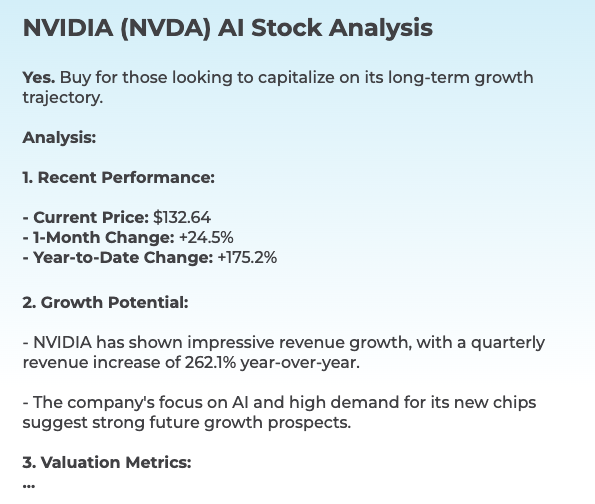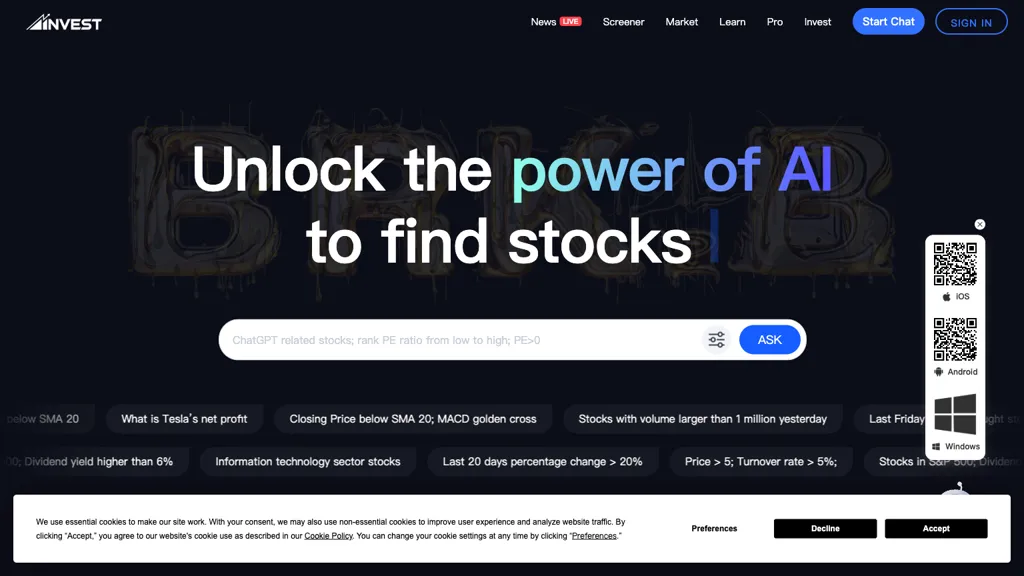20 Good Tips On Choosing AI Stock Investing Platform Websites
20 Good Tips On Choosing AI Stock Investing Platform Websites
Blog Article
Top 10 Tips To Evaluate The Integration Of Ai Stock Prediction And Trading Platforms
Integration and compatibility are critical elements when it comes to evaluating AI platforms for analyzing and predicting stocks. A platform that seamlessly integrates with your current tools such as systems, workflows, and processes can significantly enhance efficiency and effectiveness. Here are the 10 best suggestions for evaluating the integration and compatibility between these platforms.
1. Check Brokerage Integration
Supported Brokers: Make sure the platform you choose to use is compatible with your favorite brokerage account or trading platform.
Trade execution: Find out if your platform allows you to make trades directly through the integrated broker.
Account synchronization: Make sure that the platform is able to connect in real time to your accounts, balances and positions and transaction history.
2. Assessment of API availability
API access: Make sure that the platform has an API (Application Programming Interface) for developers to build custom tools or automate workflows.
API documentation: Verify that the API has clear examples with use cases.
Rate limits. Check that the API you are considering has reasonable rates and is able to handle the volume of your use.
3. Review the integration of third-party tools
Popular Tools: Make sure the platform has integrations with other applications, like Google Sheets and Excel.
Data import/export: Make sure the platform enables easy export/import data from and into other tools.
Plugins/Extensions: Check if your platform is able to support extensions and plugins that can provide more features.
4. Test Compatibility Operating Systems
Desktop compatibility is important. Make sure that your platform will work with the operating system you prefer (Windows MacOS Linux).
Mobile compatibility: Determine if there is a mobile application available for iOS or Android.
Access via the internet (for added flexibility): Verify that the platform can be accessed via the web browser.
5. Evaluate Data Integration Capabilities
Data sources: Check that the platform integrates with multiple data resources (e.g. market data providers or news feeds).
Real-time Data Feeds Look to see if your platform provides real-time analysis.
Find out if your platform supports historical data importation to analyze or backtest.
6. Check compatibility with cloud and on-premise
Cloud-based platform that is accessible any time, anywhere, as long as you have an internet connection.
Solutions on-premise: If you prefer on-premise deployment, confirm that the platform you are using supports it.
Hybrid models: Determine if the platform combines cloud-based and on-premise capabilities.
7. Make sure to check for Cross Platform Syncronization
Device synchronization. Check that data and settings are synced across all platforms (desktops mobiles tablets).
Check if changes made to a device are instantly reflected on another.
Offline Access: Check to see if there are any limitations on the functionality of the platform or access to data if it is offline.
8. Evaluation of compatibility with trading strategies
Algorithmic Trading: Make sure the platform is compatible with algorithmic or automated trading strategies.
Custom indicators: Check if your platform allows indicators or scripts that are specific to your needs.
Strategy backtesting. Find out if the platform supports strategies that are tested back using the past data.
9. Examine Security and Compliance
Data encryption: Ensure that the platform utilizes encryption for data that is in both in transit and at rest.
Verify that the platform provides secure methods for authentication (e.g. Two-factor authentication).
Regulatory Compliance: Check if your platform complies the relevant regulations.
10. Test Scalability and Performance
Scalability - Make sure that the platform you select can handle your growing requirements in terms of data and data.
Performance during load: Verify whether the platform performs as expected under high-volatility conditions.
Resource usage - Check that the platform efficiently uses system resources like CPU, memory or bandwidth.
Bonus Tips
Customer feedback: Read customer reviews and testimonials in order to assess the capabilities to integrate the platform.
Free Trial: Try the platform's integration with the existing workflow and tools with trial or demo.
Customer Support: The platform must offer robust support in the event of integration problems.
You can test the compatibility, integration, and efficiency of AI stock trading platforms using these suggestions. See the top rated ai for trading for more examples including ai stock trading bot free, ai for investment, ai stock trading app, ai trade, ai for investing, best ai stock, chart ai trading assistant, investing ai, market ai, best ai stock trading bot free and more.
Top 10 Tips For Evaluating The Speed And Latency Of Ai Trading Platforms
The speed and the latency of a trading platform are important factors to consider, especially in the case of active traders, algorithmic and high-frequency investors. Even milliseconds delay can have a negative impact on trading execution. Here are 10 top methods to determine the speed and the latency of the platforms.
1. Data feeds that are real-time: How do you evaluate them
Time to deliver data: The platform should provide precise, real-time data in the shortest amount of time (e.g. with sub-millisecond delay).
Find out the distance of the source to major exchanges.
Data compression: Verify if the platform uses effective techniques for data compression to speed up data delivery.
2. Test the speed of trade execution
Order processing time It is the amount of time it takes for the platform to process and complete trades after you have placed an order.
Direct Market Access: Make sure that the platform you are using offers DMA. DMA is a feature which allows you to transfer orders directly to exchanges and without intermediaries.
Execution reports: Find out whether the platform offers detailed execution reports, including timestamps for the submission of orders, confirmation of orders, and fill.
3. Assess Platform Responsiveness
User interface (UI) speed: Check how fast the UI on your platform responds to your inputs (e.g. click buttons or loading charts).
Chart updates. Verify that charts and visualizations have a real-time update with no lag.
Performance of mobile apps When you are using a mobile application make sure it runs just as fast as a desktop version.
4. Look for infrastructure that is not low-latency.
Servers' location The platform is running a low-latency servers that are close to financial hubs and exchanges.
Co-location: If the platform provides co-location, you can place your trading algorithm on servers that are near the exchange.
High-speed networks: Determine if the platform is running fiber optic networks that are high-speed or technology with low latency.
5. Evaluation of Backtesting and Simulation speed
Test the platform's capability to analyze and process historical data.
Simulation latency: Ensure the platform is able to simulate trades in real-time with no any noticeable delays.
Parallel processing: Ensure that the platform is using parallel processing or distributed computing, which speeds the process of complex calculations.
6. The API Latency Measurement
API response time It is the time at the rate at which an API platform responds to requests.
Rate limits: Make sure you know whether API has reasonable rate limits to prevent delays in high-frequency transactions.
WebSocket: Check whether the platform is compatible with WebSocket protocols which permit streaming data in real time with minimal latency.
7. Test Platform Stability Under loads
High-volume Trading: Play with large numbers of trading scenarios to see if the platform is responsive and stable.
Market volatility: Try out the platform in times of high volatility in order to determine if it is able to cope with rapid price changes.
Stress testing: Find out whether the platform has the tools to stress test your strategies under extreme circumstances.
8. Examine Connectivity and Network
Internet speed requirements: Make sure that your connection is at the recommended speed of your platform.
Redundant connections: Check if the platform supports redundant internet connections in order to avoid downtime.
VPN latency. Check if you're using VPN. Verify if you are using a VPN if this introduces latency.
9. Check for Speed Optimization Features
Pre-trade analytics: Make sure that the platform has pre-trade analysis to optimize the speed of execution and order routing.
Smart order routing (SOR): Verify if the platform uses SOR to identify the fastest and cost-effective execution sites.
Monitoring latency: Verify whether the platform has tools to monitor and analyze latency in real-time.
Review Benchmarks and User Feedback
Feedback from users: Use reviews of users to evaluate the platform's performance with regard to speed and latency.
Benchmarks from third parties Check out independent reviews or benchmarks comparing the speed of the platform with that of its competitors.
Case studies: See whether the platform has cases studies or testimonials that highlight the platform's low-latency capabilities.
Bonus Tips
Trial period: You are able to make use of a demo or trial to test out the performance of the platform and its latency.
Support for customers: Make sure the platform has customer support to optimize latency and other issues.
Hardware specifications. Verify whether the system is compatible with a specific type of hardware, such as high-performance computers.
If you follow these guidelines, you can effectively assess the performance and speed of AI stock predicting/analyzing trading platforms make sure you select a platform that meets your trading needs and minimizes the time it takes to complete. Low latency trading platforms are crucial for high-frequency algorithmic traders. Small delays can negatively affect their earnings. Have a look at the best ai stock analysis blog for website info including ai software stocks, ai share trading, ai options trading, best ai stocks to buy now, ai for trading stocks, ai trading tool, invest ai, ai stock prediction, how to use ai for copyright trading, how to use ai for stock trading and more.